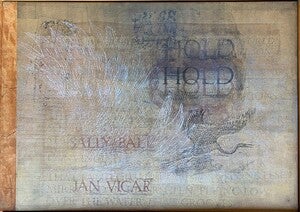
Layer upon layer of ink. A shimmering iridescence. A poem.
All describe a really big book.
An exhibition. Students and classes. Global leaders.
All inspired by this complex composition.
A curator. A professor. An artist.
All involved in bringing this book to the public.
“Hold” is the collaborative work of Czech artist, Jan Vičar, and ASU professor and author, Sally Ball. Measuring an impressive 52 cm x 65 cm (roughly 20 x 26 in), the 62-page artist book features Ball’s poem, ‘Hold,’ and 70 linocuts. It will be produced in an edition of 35; each copy is unique and also demonstrates Vičar’s evolving artistry as he progresses in producing the edition of 35. ASU’s copy is number 19 and was printed and assembled in 2021 but used plates engraved in 2017-18.
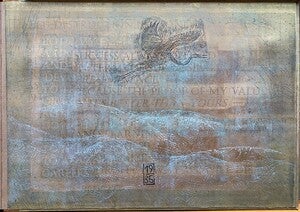
Printed on 300 gsm (gram per square meter), white Somerset English paper, each page of copy 19 passed through Vičar’s press 5 times, adding different layers of ink and impressions. He used offset ink which is specially formulated so that it does not interact with other chemicals on the dampened offset plate on the press. The typeface used to print the text is Antiqua. For the images and textures, Vičar used linocuts, a printing technique for which a design is cut into a sheet of linoleum to create a relief surface. For this, Vičar used only scrap linoleum to keep with the poem’s environmental theme. He then added visual accents to the printed pages using materials he found such as scraps of wood and cardboard.
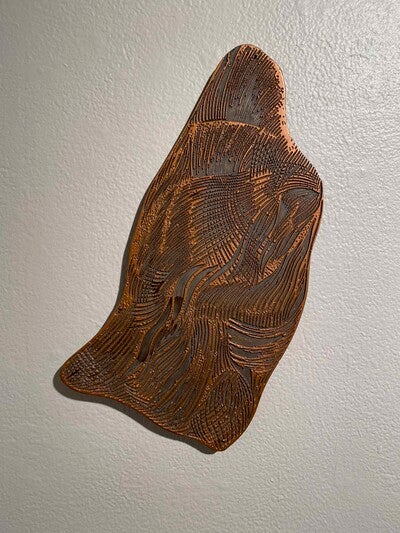
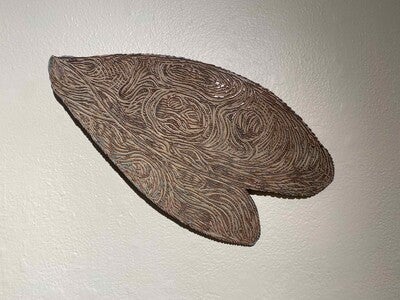
In addition, the artist lightly printed parts of the text behind each other as well as in and around images. This technique allowed him to create visual echoes of the texts and themes and to make connections throughout the work. In the example below, he lightly prints:
AND THEY COME TOO
WHEN THE MOON LEANS FORWARD
OVER THE MOUNTAIN,
HUGE, LIKE AN AWARD
FOR BEING IN LOVE
in the bottom left behind the main text on this page, echoing the main text two pages before.
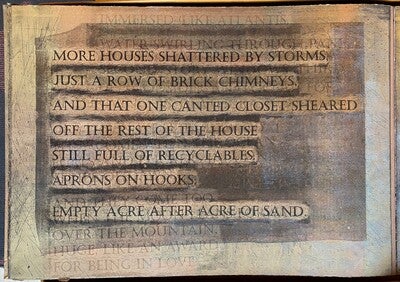
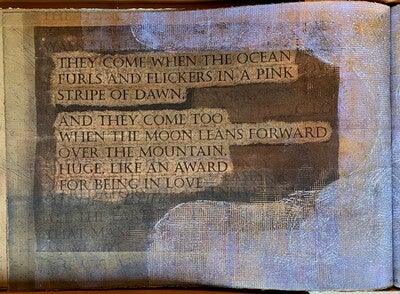
This multistep, complex process requires 6 weeks per copy to create a finished book. Bound in a handsewn leather binding, the final product is a work of art that engages viewers’ senses. The heft of the volume as it is removed from its protective enclosure stimulates the arm muscles while fingers feel the soft, fuzzy suede on the binding. As the book is opened and the pages turned, the smell of the ink fills the nose. Then the eyes lay hold of the many layers of ink and color that create a depth and richness that is difficult to capture even with the highest quality photography. This visually stunning, physical object demands a viewer to be physically present in order to appreciate its very complex composition.
This remarkable volume, number 19, now calls ASU Distinctive Collections home. It is part of the Rare Books and Manuscripts (RBM) collection and numbers itself among the other contemporary artist’s books in RBM. An important acquisition no doubt, but this volume’s acquisition represents what a special collections repository does when it’s working well. What does that mean?
The purpose of a special collections unit at an academic library is not just to acquire material to have items. A well-functioning unit acquires materials, such as “Hold,” with an eye towards the teaching and research needs of the university and of its students and faculty. It considers existing program strengths. It develops collaborations both on and off campus. It engages in collaborative projects to provide access both physically and virtually. It provides instruction to students and the public. It hosts public events to provide all people interested with opportunities to engage with the collections. It encourages people to bring their unique experiences and to discover and share their ideas generated while engaging with the collections. It strives to foster inquiry and critical thinking and encourages diverse perspectives. A well-functioning special collections unit strives to do all of these things and continually looks for new opportunities to engage all communities from campus to the local community to those across the globe.
RBM’s acquisition of “Hold” is part of the series of partnerships, collaborations, instruction, events, public engagements, and on-going plans that demonstrate ASU Distinctive Collections is working well.
How Distinctive Collections’ partnership started
This partnership was born in early August 2020 as ASU was about to restart after the pandemic had disrupted the Spring 2020 semester. With the uncertainty of how this restart would work, Distinctive Collections reached out to faculty to let them know we would work with them to figure out ways of making materials accessible for their classes. One response to this email was an inquiry from Sally Ball, Professor of English and Director of Creative Writing at ASU, about a project she hoped to collaborate on. Thus began the project regarding this big, heavy book.
Before diving into all aspects of this partnership, there was another partnership between Sally and the Czech graphic artist that made this possible. In 2015, Jan Vičar, the graphic artist, approached Sally about creating an artist’s book based on her poem ‘Hold.'
Sally contrasts her examination of a range of topics including climate anxiety, nuclear energy, migration with the beauty of the world in her poem that anchors the volume of collected poems, “Hold Sway.”



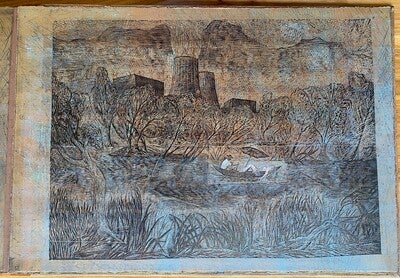
With support from ASU’s Virginia G. Piper Center and the Institute for Humanities Research, this project came to fruition. The finished product, “Hold,” debuted in the US in October 2018 with events at the University of Texas, Austin’s New Writers Program and Michener Center and the Phoenix Art Museum.
Fast forward to 2020. In August 2020, Sally and Julie, Curator of Rare Books and Manuscripts, discussed collaborating on a special project. This project offered so many possibilities that would enrich the learning experiences of ASU students, especially in the Creative Writing and Design programs, as well as anyone interested in the environment, sustainability, art, poetry, and more. As we talked about all of the possibilities for how “Hold” could be used on campus and ways of bringing ASU faculty and student expertise and ideas and special collections to a wider audience beyond campus, the rationale to acquire a copy of this monumental artist’s book for Rare Books and Manuscripts was clear. ASU Distinctive Collections is one of two institutions in the United States that holds a copy of “Hold.” The other copy, a much earlier printing, is part of the University of Iowa’s collection. The only other additional copy in the United States is owned by a private collector.
Distinctive Collections, ASU, and “Hold”
After placing an order for “Hold” and contending with the surprises that the pandemic threw everyone’s way, ASU’s copy finally arrived, hand delivered by the book artist himself. Jan explained to me the specific features of ASU’s copy and described the processes used to create the multiple layers. He talked about the evolution of the project and differences between ASU’s copy and earlier ones. ASU is fortunate to have copy 19 with its remarkable depth of layers and colors. It has more colors and layers of text in comparison to the University of Iowa's copy, number 13 of 35 from 2017. Words cannot describe the complex interaction between viewer and object that depends on the lighting and position of the viewer.

Expeditiously cataloged by our phenomenal special collections cataloger, “Hold” made its way to the Harry Wood Gallery in ASU’s School of Art to be exhibited along with other work by Vičar. In “So Much of the World Stays Beautiful,” the book, front and center, stood before a wall tiled with all of the pages from an unbound copy. While on exhibit, Jan welcomed students and instructors to meet with him in the gallery. In addition, ASU hosted the Alliance Française of Phoenix for an after hours talk about and viewing of “Hold.”
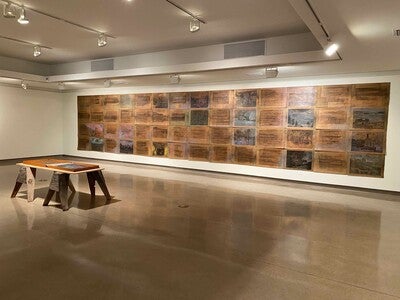
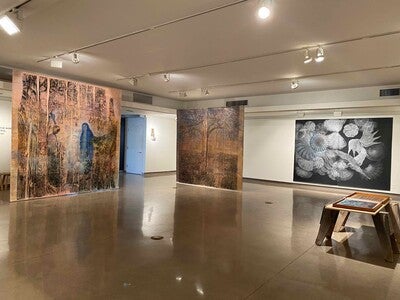
Once the exhibit came down in February, “Hold” returned to Distinctive Collections and got to work. This artist book was used for multiple classes during the Spring 2022 semester, including classes from Art and English. In one class, in particular, groups of students returned multiple times to the table where “Hold” was displayed. One group of four students stood in conversation for well over 20 minutes, examining the layers, and, walking back and forth, were almost giddy about how the colors changed and the shimmering effect the light created. They discussed the different printing processes they thought were used and how many different layers were needed to create the effect they saw. When they compared it to digital surrogates displayed on a laptop next to the object, the students all commented, “Digital just doesn’t do it.” That is the whole point—this is why Rare Books and Manuscripts acquired a physical copy of “Hold.”
“Hold” was also featured during a session for ASU’s student club, A Buncha Book Artists Collective (ABBA), advised by Dan Mayer, Director of Pyracantha Press, and other artist’s book enthusiasts. Attendees made comments similar to the four students just mentioned and also marveled at how heavy each of the pages was because of the amount of ink on it. Another person also pointed out that you could smell the ink—this was a fully sensory experience (though tasting the object was strongly discouraged). The expert printer in the room, Dan Mayer, explained more about the processes involved, answering questions from the onlookers as they stood in awe.
The poet, Sally Ball, and I were also organizing an event for late April to celebrate National Poetry Month. With “Hold” as the featured item, we planned to showcase the collaborative efforts between ASU faculty, the library, and students. Sally agreed to read her poem and talk about the relation of the images and symbols in the artist book she and Jan collaborated on. We were also going to showcase ASU undergrads and their creative projects on similar themes related to poetry and the environment. Due to circumstances beyond our control, we’ve postponed this event and anticipate inviting the public to come see the great work of our students, faculty, and library next school year.
With our sites set on promoting Rare Books and Manuscripts’ collections and making our materials more easily accessible to all interested, Sally and I have begun discussing creating a video about “Hold.” Although we haven’t finalized the details, the idea has been sparked and talks are in progress. Stay tuned.
“Hold” and its life beyond ASU
Copy 19 lives a full life here at ASU, but it also is connected to the life of “Hold” in the contemporary, global context. This summer, France’s President, Emmanuel Macron, will hand over the presidency of the European Union to Miloš Zeman, President of the Czech Republic. In anticipation of the July transfer of leadership, Jan Vičar, a native of the Czech Republic, was invited by the Czech Ministry of the Environment to present “Hold” in February 2021 to all of the international ambassadors currently stationed in Prague as a symbol of international collaboration and Europe’s commitment to environmental care.
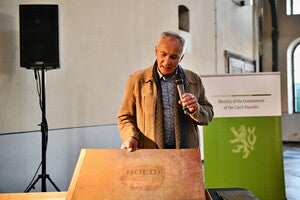
That event was a precursor to the upcoming transfer of leadership. In July, one of the ceremonial events when the presidency changes hands will be an exhibition of “Hold” and related works by Vičar that are also inspired by the poem at the Museum of Decorative Arts in Prague. Ball is also scheduled to attend and participate in this event.
“Hold” has also been exhibited internationally at venues that include:
- Prix Mario Avati (May-June 2021; prize announced/awarded in 2018 resulting in the exhibition at the Académie des Beaux Arts)
- Académie des Beaux Arts in Paris (May-June 2021; originally scheduled for December 2020 but postponed)
- Maison des Artistes in Schwandorf, Germany (February 2019)
- CCS Galerie in Thuringia, Germany (August-October 2018)
- Czech Center in Tokyo (June 2018)
- La Fileuse in Reims, France (July 2017)
- Fig Bilbao in Spain (Summer 2017)
- among other venues
“Hold” is also held in the following libraries and museums:
- Bibliothèques Nationale de France (2022)
- Bibliothèque de l’Institut de France (2021)
- Museum of Czech Literature, Prague (2021)
- Vysočina Regional Gallery, Jihlava, CZ (2021)
- and several private collections
About the artists (Bios courtesy of Sally Ball)
Sally Ball is the author of “Hold Sway” (2019), “Wreck Me” (2013), and “Annus Mirabilis” (2005), all from Barrow Street. She is a professor of English at Arizona State University, a faculty member of the Warren Wilson College MFA Program for Writers, and an associate director of Four Way Books. Her work has appeared in “The American Poetry Review,” “Boston Review,” “Harvard Review,” “Scoundrel Time” (first publication of “Hold”, awarded their Editors’ Prize for that year), “Tin House,” and elsewhere. She lives in Phoenix. More information at http://saralouiseball.com
Jan Vičar studied at the Academy of Fine Arts in Prague. He has exhibited his work around the world—across Europe, in Japan, the United States, and South Africa; and it is held in collections including the National Gallery in Washington, DC. He has twice won Prague’s Print of the Year in the experimental category. He is the recipient of the 2018 Prix de Gravure Mario Avati from the Académie des Beaux Arts in Paris and the Premio Leonardo Sciascia Prize in Milan in February 2022. He lives outside of Telč in the Czech Republic. More information at http://janvicar.com
By Julie K. Tanaka
Curator of Rare Books and Manuscripts and Interim Head of Distinctive Collections